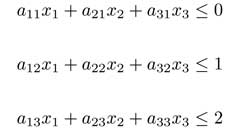Cancer Chemotherapy: A drug regiment given to cancer patients to attempt to stop cancers from becoming larger or spreading to other parts of the body. These drugs accomplish this task by killing cells in the patient’s body.
Cancerous Proteins: These are in reference to the proteins that exist as molecules in your body which change when cancer is present. These changes occur because the cancer has taken over the organ in which that chemical is present, or the cancer changes the protein so that it can more easily spread to other organs or body systems.
Proliferate: To spread or grow rapidly.
Retinoic Acid Receptor gamma-2: A type of protein found within the cell that is responsible for detecting thyroid hormones.
Matrix: A rectangular array of numbers; in this case, the numbers are zeroes and ones. Matrices are named by the number of rows then the number of columns. For example, a 2 x 3 matrix has 2 rows and 3 columns.

Vector: A matrix consisting of strictly one column and a variable number of rows.

 : summation notation. The i on the bottom represents the number that the summation begins with and the n on the top represents the number the summation ends with. The function of x that follows the summation is what is applied to each value of x between i and n. For example:
: summation notation. The i on the bottom represents the number that the summation begins with and the n on the top represents the number the summation ends with. The function of x that follows the summation is what is applied to each value of x between i and n. For example:

Matrix Multiplication: In general, we can take the product AB only if the number of columns of A equals the number of rows of B (so that we can multiply the rows of A by the columns of B). If A has more than 1 row, the product of each row of A by column of B must be added.
Example 1:



Example 2:



Matrix inequalities:


 means
means

or

